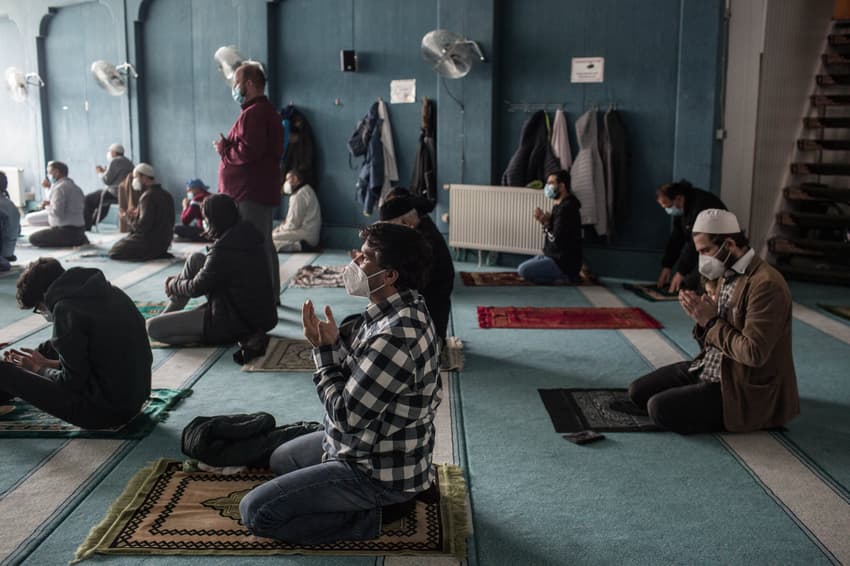IN NUMBERS: A breakdown of Germany's Muslim population

Around 5.5 million Muslims live in Germany, almost one million more than five years ago. And now the group is more diverse than ever before, according to a new study.
The study, conducted once every five years, was presented this week in Nuremberg by the Interior Ministry.
It found that between 5.3 and 5.6 million people of the Islam faith currently live in Germany, making up a share of 6.4 to 6.7 percent of the country's total population - which stands at around 83.2 million.
Compared to the last projection amid the refugee crisis in 2015, the number of Muslims in Germany has increased by around 900,000 people.
"The Muslim population has become more diverse in the context of immigration from Muslim-majority countries in the Middle East in recent years," said BAMF President Hans-Eckhard Sommer.
Turkey continues to be the largest country of origin, accounting for 45 percent of the Muslim faith population. However, 27 percent now also come from Muslim-majority countries in the Middle East and North Africa, and almost 20 percent from southeastern Europe.
READ ALSO: Eight things to know about Islam in Germany
The study showed that levels of how religious people define themselves vary: 82 percent consider themselves strongly or ‘rather’ religious, and 39 percent of Muslims in Germany pray daily.
Yet only 30 percent of Muslim women and girls wear headscarves. But among women over the age of 65, the majority (62 percent) wear a head covering.
Most Muslims would rate their German language skills as good or very good (79 percent). And almost most all Muslims who were born in Germany state that they have a very good knowledge of German (93 percent).
Religion and integration
Presenting the report, Sommer said that factors such as length of stay in Germany, reasons for migration, or the overall social situation shape the integration process to a far greater extent than religious affiliation.
Belonging to a German Verein (association) and learning the language are also key factors fostering better integration, he continued.
The number of Muslims with vocational training is significantly higher in the second generation than among those who have emigrated themselves.
"The analyses also show that the influence of religion on integration is often overestimated," Sommer said.
Vocabulary
The faith - (der) Glauben
Headscarf - (das) Kopftuch
Country of origin - (das) Herkunftsland
overestimated - überschätzt
We’re aiming to help our readers improve their German by translating vocabulary from some of our news stories. Did you find this article useful? Let us know.
Comments
See Also
The study, conducted once every five years, was presented this week in Nuremberg by the Interior Ministry.
It found that between 5.3 and 5.6 million people of the Islam faith currently live in Germany, making up a share of 6.4 to 6.7 percent of the country's total population - which stands at around 83.2 million.
Compared to the last projection amid the refugee crisis in 2015, the number of Muslims in Germany has increased by around 900,000 people.
"The Muslim population has become more diverse in the context of immigration from Muslim-majority countries in the Middle East in recent years," said BAMF President Hans-Eckhard Sommer.
Turkey continues to be the largest country of origin, accounting for 45 percent of the Muslim faith population. However, 27 percent now also come from Muslim-majority countries in the Middle East and North Africa, and almost 20 percent from southeastern Europe.
READ ALSO: Eight things to know about Islam in Germany
The study showed that levels of how religious people define themselves vary: 82 percent consider themselves strongly or ‘rather’ religious, and 39 percent of Muslims in Germany pray daily.
Yet only 30 percent of Muslim women and girls wear headscarves. But among women over the age of 65, the majority (62 percent) wear a head covering.
Most Muslims would rate their German language skills as good or very good (79 percent). And almost most all Muslims who were born in Germany state that they have a very good knowledge of German (93 percent).
Religion and integration
Presenting the report, Sommer said that factors such as length of stay in Germany, reasons for migration, or the overall social situation shape the integration process to a far greater extent than religious affiliation.
Belonging to a German Verein (association) and learning the language are also key factors fostering better integration, he continued.
The number of Muslims with vocational training is significantly higher in the second generation than among those who have emigrated themselves.
"The analyses also show that the influence of religion on integration is often overestimated," Sommer said.
Vocabulary
The faith - (der) Glauben
Headscarf - (das) Kopftuch
Country of origin - (das) Herkunftsland
overestimated - überschätzt
We’re aiming to help our readers improve their German by translating vocabulary from some of our news stories. Did you find this article useful? Let us know.
Join the conversation in our comments section below. Share your own views and experience and if you have a question or suggestion for our journalists then email us at [email protected].
Please keep comments civil, constructive and on topic – and make sure to read our terms of use before getting involved.
Please log in here to leave a comment.